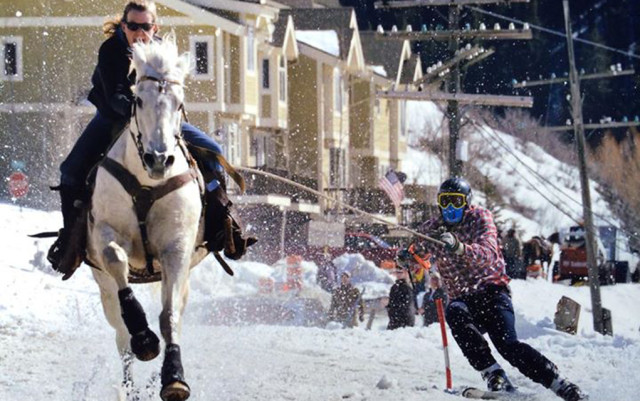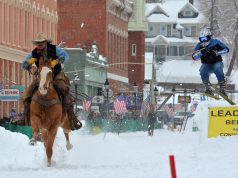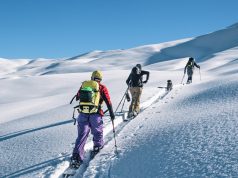
Lightening acceleration. Blistering speeds. Crashes and podium finishes. Teamwork and tradition. These are the elements of skijoring, an obscure sport with a rich history that’s making a comeback across the Rocky Mountain region. It’s a game of grace and beauty and speed and adrenaline, as teams of a horse, a rider and a skier blast down snow-covered courses that include jumps and gates: drag racing with a twist, fastest time wins.
According to historians of the sport, skijoring is an ancient test of man, beast, teamwork and guts. While the origins of the sport as competition are shrouded in the mists of time, the earliest known records of men (or women) on skis being pulled by an animal date from thousands of years ago, from the Altai Mountains in central Asia. The concept of ski- and animal-assisted travel across snow spread through Lapland, Finland, where reindeer are still utilized as an essential part of the equation combining man, skis and snow to cover vast distances. Eventually the Rocky Mountain West got into the act.
Of course, at some point, someone decided to race a friend or family member, and the utilitarian function of travel over snow evolved to the competitive sport of skijoring. Globally, the sport hit a zenith in the early 1900’s, making a debut at the Stockholm Winter Games in 1901, and being featured as an exhibition event in the 1928 Winter Olympic games in St. Moritz, Switzerland. Closer to home, the 1976 Winter Olympic bid by Denver also featured skijoring as an exhibition sport.
Today, Colorado features top level competitions, including races in Silverton, Leadville and Minturn. And, while the Olympic dreams are probably on hold for now, the events have evolved into something that’s perhaps more powerful: the opportunity to compete or take part as a spectator, to get up close and personal with some of the best athletes in the event today.
The Minturn race is just around the corner, happening Feb. 26-28. Organized by Rocky Mountain Extreme Skijoring, it’s part of a four-event series that also features competitions in Jackson Hole, Wyoming, Leadville, Colorado and Teton Valley, Idaho.
The races feature teams of a rider, a horse and a skier competing on an 800-foot-long course. The action is intense and mesmerizing. The horses accelerate to 40 miles-per-hour in three strides, while hitting a top speed of 43 mph. Skiers can max out at 60 mph thanks to the pendulum effect of being towed behind the equestrian team. Speeds that make navigating the courses — which feature gates akin to a slalom and rings that must be speared, sometimes using a sawed off ski pole — fiendishly difficult. Finally, there are the jumps, which dramatically increase the difficulty for the skiers as they attempt to snare the rings and navigate gates, crucial to avoiding the time penalty that comes from missing a gate or a ring.
If it sounds dangerous, well, it can be. But the athletes that participate in the serious racing — and we include the horses in this category, because they’re athletes too — have worked their way up. For the never-evers and those who are still getting their legs, the novice or “sport” category is less intense but no less exciting.
“You compete in the sport division first,” says Bruce Stott, a former Boulder resident who attended the University of Colorado and who now lives in Frisco. He’s competed in skijoring since 2000, when he signed up for an event in Summit County on a whim.
“I started right after college,” Stott says. “I did a race in Frisco and thought, ‘Wow, this is fun.’”
Stott now races in the “open” category, where the horses are fast and the stakes higher. If you do well in the sport division, he says, “it is easy to meet up with the horse people.”
And, according to Stott, that’s the key to winning races, because the horse people are the gate-keepers for the rock-star athletes who can make or break your game come race day. “There’s a few horses that are known to be really fast,” Stott says. “These horses come off of the race tracks, from barrel racing and roping. They’re from ranches and are working horses.”
The horses have names like Rocket, Tank, Merlin and Red. They’re fast and beautiful and, like many top performers, sometimes a big quirky.
“I won’t discount the relationship you have to have with a horse,” says Dana Stiles, a longtime competitor who is making the transition from Merlin to a new steed this year. “Trust is the issue.”
Stiles has been competing for more than 20 years and got her start at a now-defunct event in Avon. “I knew about the event in Leadville, but I would always forget about it,” admits Stiles. “I’d then hear about it in the winter, but my horses were always out of shape. And I wasn’t going to pull a fat horse out of the pasture to go race at 10,000 feet.”
“You need a fast horse and a good skier,” Stott adds. “For Minturn you have to go around gates, over six 7-foot jumps and collect rings. Miss a ring or a gate, and it’s a penalty. The start is the key.”
“Trying to get a good start is the key,” Stiles agrees. “It’s tough to make up time.”
That’s the reason, according to Stiles, that just like any athlete, the horses and their riders (as well the skiers) have to train to be ready to go when the bell rings, making skijoring more than just a passing spectacle on a cold winter day.
“There are some people who are really serious, ex ski racers — I don’t like to look at them as ski bums or hippies. They’re athletes, and our horse riders, they’re not just a bunch of rednecks,” Stiles says. “As a whole, the skjouring community is pretty dedicated. You have teams in Minturn from Montana, Wyoming and Idaho. These teams have been to two or three or four races this year already. And they’ve trained in the snow and the crap, you have to if you are going to be ready.”
Still, despite this core of professionalism and commitment, skijoring today remains a grassroots phenomenon, a back-to-the-future movement that echoes a rich and illustrious past, fueled by community and volunteers, who work tirelessly to promote, host and run events.
But don’t be fooled. The sport is poised to explode across the West once again, with plans for junior and pee wee events in the works, and more and more races across the region each year.
“A hundred years ago in Steamboat there was a circuit in existence, with events in Baggs, Pinedale and Jackson,” Loren Zhimanskova says. “And today it’s the same, it’s all about the community having a great time supporting cowboys, cowgirls and skiers, they all come together for skijoring and the teams love collaborating and trying to [develop] strategies to get the fastest, cleanest run.”
Zhimanskova is the owner of Skijor International, which seeks to promote the sport, and also serves on the board of RMX Skijoring, the organization partnering with Minturn to host the event.
Zhimanskova got hooked at the first skijoring race she went to. “I was volunteering and helping to write down the times,” she recalls. “I loved it. There are few things that give you more of an adrenaline rush than seeing a horse go flying right by you and then seeing a skier right behind them.”
“We wouldn’t have these races if the ranching communities with the riders and horses, and the ski communities didn’t all work together,” Zhimanskova adds. “There aren’t many events that pull these people together successfully, and for the spectators that’s fun.”
And, Zhimanskova says, the horses like it too.
“Not every horse is going to be comfortable towing a skier, or ready for the experience of being around crowds of people cheering,” she says. “It takes training and the right horse. The horses are generally quarter horses or appendix horses, which are combination of thoroughbreds and quarter horses. They’re quick out of the gate. When you stand at the start line you see that the horses are so excited, they love to run and they love to compete.”
It’s also worth noting that, according to Zhimanskova, “a lot of the horses are rescue horses.
“They really are athletes,” she says, “and the fact that they are participating in a sport is really heartwarming.”
Also heartwarming is the fact that at the Minturn races 10 percent of the purse is reserved for the horses, a nod to the fact that these athletes are an integral part of the team and deserving of a taste of the victory spoils.
The money is nice, but there are still some challenges. The fans who fall in love with these four-legged speed machines will find that getting their favorite athlete’s autograph will still be pretty tough.














